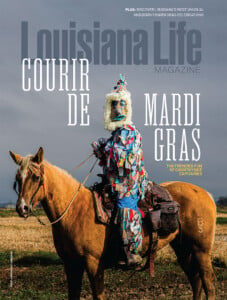An Artist’s Journey: Kim Howes Zabbia’s Path from Teacher to Artist

Enchant
Art, to Ponchatoula artist, teacher and writer Kim Howes Zabbia, is about freedom, control, creativity, fear. Her paintings and sculptures express the intuitive exploration of her own subconscious as it responds to her surroundings and to the rural Louisiana landscape.
Born in 1952, the Ponchatoula native has enjoyed a long and successful career as an artist, teacher and writer. It is a career that began as a child with a mother who taught her how to draw what she could see and a father who taught her how to create what she could not see. “He taught me creativity,” she says, “and Mom taught me the technical end.”
To an observer, Zabbia’s life as a teacher, writer and artist seem inseparable. With degrees in English, journalism and art from Southeastern Louisiana University and a master’s in fine arts from LSU, Zabbia taught art at Ponchatoula High School for 32 years before retiring in 2007. The next day she opened The Art Station in Ponchatoula as an art school for adults. Fifteen years later she sold the school and began teaching art part-time at Ponchatoula’s Twin Steeples Creative Arts Center.

Channeling
“I couldn’t imagine not teaching,” says Zabbia, who is married to Ponchatoula’s long-time former mayor Bob Zabbia. “We mostly do critique sessions at the art center. But what I love most is networking artists, being able to connect artists and helping them with their careers. I did a talk called ‘It’s not bad art, it’s bad marketing.’ Visual artists are not competitive. They are so willing to share ideas that they have. It’s a great community to be a part of.”
Teaching artists how to market their work is one of several underlying themes in her book “Just Paint, It Ain’t.”
“Artists have to realize that their job is a jungle gym, it’s not a ladder,” she says. “They are not climbing up a ladder and at the top is a gallery to take care of them. They have to understand that they make a career out of being an artist by creating a product but also by doing a workshop, also doing a market, taking commissions, doing merchandise and marketing the product.”

Silhouette
Zabbia’s first book, “Painted Diaries,” published in 1996, is an emotionally moving story that explores through paintings her mother’s journey into Alzheimer’s disease. Even the paintings in this book are subconscious responses to her mother’s condition.
“Everything comes from the subconscious,” she says. “It comes from 73 years living in this atmosphere. I’ve often told artists that if you plan a painting, you are opening yourself up to disaster before you even begin. It’s better to not think that much. Just move right into it and let the paint do its job. I never paint what I’m looking at. I can paint what I see, but the key to my painting is that I leave myself completely open to whatever the paint shows me.”
Like most artists, Zabbia titles her paintings, but they are never direct descriptions of the subject matter. She wants viewers to think about the imagery.

Calming
“That’s why the titles are never obvious,” she says. “There are three ways to title a painting. You can title it exactly what it is, you can title the method you use or you can give it a title that makes the viewer think. I like that third method. So, I stick with adjectives, verbs or vague nouns that will make them think. They give you a hint of what the artist had in mind, but I’d rather they put their own feelings into the painting instead of trying to figure out what mine were.”
As to her painting style, Zabbia says her work most resembles Surrealism, that post-World War I avant-garde art movement that unleashed the subconscious and championed artists such as Salvador Dalí.
“The Surrealists are my favorite,” says Zabbia, who paints mostly in her studio rather than on location. “They all have hidden images in them. That makes people stay and look at them longer and longer.”

When asked how she feels when painting, she laughs slightly and says: “Frustrated, ticked off, angry and finally when I’m ready to throw it in the trash, I go, ‘Oh, it’s a masterpiece.’ My biggest problem is that I keep working on it. Paintings are never finished, they just stop in interesting places, so Picasso said. I sometimes work them to death.”
Though she may get “frustrated” or “ticked off,” Zabbia says she must paint and sculpt. “You just have to do it,” she says. “You have to create something. Once you get into it, you realize how therapeutic it is. It helps you become less judgmental or critical of other people.”
Through it all, there are constant underlying forces that drive her work.
“It is about freedom versus control, creativity versus fear,” she says, “You want to be as free and as creative as you can be.”
For more information, visit kimhoweszabbia.com.
